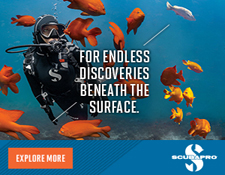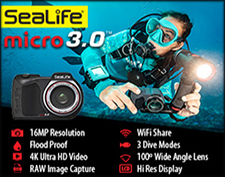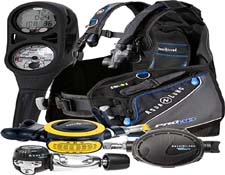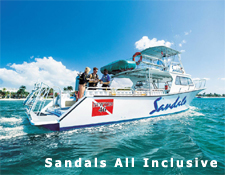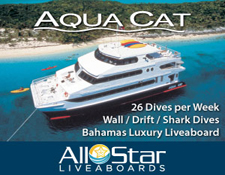Australia

Down, down into the clear blue depths. All around, the water is teeming with schools of rainbow-coloured fish
feeding on coral - pink, red and white. No-one in sight, just you and the sea.
Australia's coastal waters are an underwater paradise for scuba divers and snorkellers - sites of clear, warm
water, dazzling coral reefs, historic shipwrecks, abundant marine life and island resorts. With more than
36,000km of coastline, it offers a huge number of superb locations for divers and snorkellers - in the tropical
waters off Queensland's Great Barrier Reef and Western Australia's Ningaloo Reef to the temperate waters in the
southern States.
Diving
Beginners need not despair. Dive lessons are available at almost every
gateway city and at major resort areas for those keen to explore our
clear blue waters.
Some of Australia's most spectacular diving can be enjoyed in the
temperate waters of the Great Barrier Reef, off centres such as Cairns
and Port Douglas or the Whitsunday Islands.
The warm, clear water of Ningaloo Reef off Western Australia is also
ideal, and offers abundant marine and coral life.
Shipwreck diving is available around the coast on vessels sunk during
the 17th century through to recent times. Bass Strait, popular with
underwater photographers, and Darwin are two popular sites.
For those looking for something different, Australia is also home to the
finest freshwater cave diving in the world or dive with the infamous
Great White Sharks off the South Australian Coast.
With 36,735 km / 22,826 miles of coastline, and some great places to
dive
Snorkeling
Snorkeling is a safe, reasonably priced, and delightful way to
experience Australia's underwater treasures. Most coastal and island
resorts offer the sport. Day boat tours operate from a great number of
locations and usually provide snorkeling equipment. Snorkel over the
Great Barrier Reef or Ningaloo Reef and see marine and coral life like
you've never seen before.
Queensland & The Great Barrier Reef
Queensland is known as the holiday destination of Australia and rightly so. It is home to the Great Barrier Reef, which is the largest coral reef system in the world, and has its own dedicated PADI Vacation Spotlight. Learn more about diving on the Great Barrier Reef.
New South Wales (NSW)
New South Wales offers a rich variety of year round diving with both warm and cold-water currents spread across the coastline. In the north, you’ll encounter warmer water marine life in several marine parks. The central coast region has some spectacular sites including the HMAS Adeliade wreck. Sydney has world class diving right on the doorstep of this exciting and vibrant city. Further south, where the water becomes temperate, there are pristine sites, including more than 30 dive sites off Jervis Bay. Lord Howe Island, 700 kilometres to the east of NSW, features the world’s southernmost coral reefs with more than 60 dive sites to explore.
Victoria
Victoria is packed with attractions including incredible underwater environments only found in temperate waters. Near the lively capital city of Melbourne, the Port Phillip Bay region hosts some truly amazing wrecks and caverns. Here you’ll encounter beautiful marine life including cuttlefish, octopus, giant sea stars, rays, seahorses and even seals.
South Australia
The beautiful state of South Australia has a rich heritage that is equally matched by its natural beauty both above and below the surface. South Australia's bio diverse temperate waters offer amazing shore dive opportunities under the many jetties in and around Adelaide, as well as some stunning wreck dives! Expect to see anything from sea lions to seahorses and if you have a keen eye, maybe even the state's underwater emblem: the Leafy Sea Dragon, which can be found under many of the local jetties.
Western Australia
Famous for being bathed in sunshine, Western Australia is fast becoming a top dive destination. From Perth you can easily explore the beautiful dive sites off Rottnest Island or visit spectacular wrecks, such as the HMAS Swan. It's possible to encounter whale sharks off Exmouth or near Ningaloo Reef, Australia’s longest fringing reef.
Tasmania
Separated from the mainland, Tasmania is known for its natural and untouched beauty. With cooler water than most of the mainland, visibility can seem endless when you’re not in the middle of a giant kelp forest. The many wrecks, huge rocks structures, caverns and endemic marine species make diving in Tasmania a real adventure.
Northern Territory
The coral reefs off Darwin have a rich diversity of reef fish and invertebrates, and arguably Australia’s best collection of World War II shipwrecks and plane wrecks. Divers at Gove Peninsular East of Darwin find manta rays, reef sharks, turtles, schools of pelagic fish and even whale sharks at certain times of the year.
Some Great Dives To Check Out
North Stradbroke Island, Brisbane - The premier dive sites here, Shag Rock and Flat Rock, are home to healthy numbers of leopard and grey nurse sharks. At Flat Rock, watch for wobbegongs and turtles in the gullies. Shag Rock, with a maximum depth of 15 metres/45 feet, is popular with newly certified divers who enjoy the gullies and a swim through. Manta Ray Bommie has great viz and is visited, as the name implies, by manta rays in summer. It’s also home to leopard sharks and other abundant aquatic life.
HMAS Brisbane, Sunshine Coast - Lying in just less than 30 metres/100 feet of clear currentless water, the 133-metre/436-foot HMS Brisbane became an artificial reef for divers in 2005. Many divers consider it among the best dives in Australia. The ship was well prepared and has many entry and exit points cut in the hull. Eagle rays, turtles, kingfish and groupers prowl the wreck.
Bare Island, Sydney - This popular dive site was featured as the virus factory in Mission Impossible II. The eastern side of the island tends to have better visibility and shallower depths which make it suitable for new divers. The western side has abundant aquatic life, notably beautiful sponge gardens and a rocky reef wall with overhangs and depths to 18 metres/60 feet. Keep an eye out for Port Jackson sharks.
HMAS Adelaide, NSW – Purposely scuttled off Terrigal on NSW's central coast in April 2011, the HMAS Adelaide has diver access holes strategically placed to allow easy exploration of key areas. The wreck is developing a nice marine community that includes giant cuttlefish, grouper, kingfish, blennies, octopus, banner fish and bat fish.
Shelly Beach, NSW - The only west-facing beach on the entire east coast of Australia, this popular shore dive has nice white sand and boulders forming a natural reef for marine life. Cruising along shallower than 14 metres/45 feet, you may see a few wobbegongs and Port Jackson sharks along with huge grouper and lots of other fish.
HMAS Canberra, Victoria – This naval ship was prepared and purpose-sunk as a dive site in 2009. Sitting on the bottom at 28 metres/92 feet, the HMAS Canberra’s mast reaches up to within 5 metres/15 feet of the surface. This wreck is now a Marine Reserve and hosts a healthy variety of marine species.
Lonsdale Wall, Victoria – This long wall can be explored on many different dives. You descend along a sheer wall with small ledges and big overhangs that often create swim-throughs. Look for fish hiding under the ledges, including the western blue devil fish, and soft corals and sponges clinging to the wall.
Rapid Bay Jetty, South Australia - Relatively close to Adelaide and with easy entry and exit, this is South Australia's most popular jetty shore dive. You can see huge schools of fish in between the pylons and this jetty offers the best chances of spotting leafy sea dragons and even the occasional weedy sea dragon! Playful sunrays penetrating the old jetty above create an amazing playground for underwater photographers.
Edithburgh Jetty, South Australia – This shallow dive site hosts a remarkable diversity of marine life. The jetty structure is covered with sponges and soft corals and provides a playground for all sorts of macro life. Everything from tassled anglerfish to pyjama squid and from tiny seahorses to a playful resident seal can be found under this jetty, as well as a small colony of leafy sea dragons!
Ningaloo Reef, Western Australia – This reef lies off the remote northern coastline of Western Australia, stretching nearly 260 kilometres/150 miles from north to south - making it the longest fringing reef in the world. It supports more than 220 coral species and more than 500 fish species. However, it’s the big animals – whale sharks, humpback whales, manta rays and dugongs – that really add excitement to the area.
Rottnest Island, Western Australia – There are numerous dive sites around this limestone island, each offering something a little different. Indian Ocean currents have helped shaped deep crevices, caverns and huge swim-throughs off Rottnest, which create mazes at some sites. The fish around the island are diverse and soft coral are just sensational.
Cathedral Cave, Tasmania – This is the most visited cavern in Waterfall Bay because its three large openings make entering easy and allow light to filter in, just like a big cathedral. The cavern is around 30 metres/100 feet long and approximately 21 metres/70 feet deep. Colorful sponges and invertebrates cover the walls.
Governors Island Marine Reserve, Tasmania – The reserve contains more than 15 dives sites. You can dive on huge underwater mounds and peer into enormous caverns with soft corals growing on the walls. There are lots of fish and the odd pod of southern right whales and dolphins.
USAT Meigs, Northern Territory – The USAT Meigs is a 131-metre/430-foot long US transport ship that sank during the first Japanese air raid in Darwin, Australia during World War II. Sitting in18 metres/60 feet of water, this wreck is a popular dive. Look for a variety fish, including pygmy barracudas, golden snapper and large estuarine cod.
Source: PADI
|

















